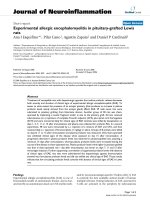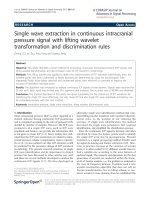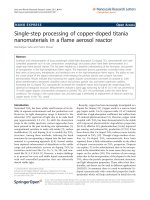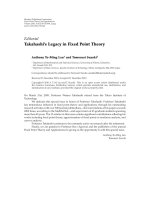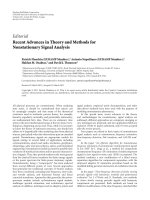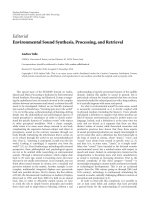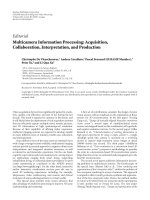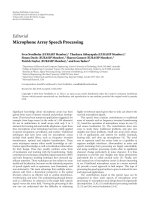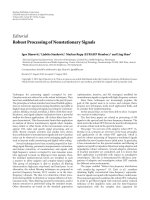Báo cáo hóa học: " Editorial Signal Processing in Advanced Nondestructive Materials Inspection" pptx
Bạn đang xem bản rút gọn của tài liệu. Xem và tải ngay bản đầy đủ của tài liệu tại đây (415.87 KB, 2 trang )
Hindawi Publishing Corporation
EURASIP Journal on Advances in Signal Processing
Volume 2010, Article ID 954623, 2 pages
doi:10.1155/2010/954623
Editorial
Signal Processing in Advanced Nondestructive Materials
Inspection
Jo
˜
ao Manuel R. S. Tavares
1
and Jo
˜
ao Marcos A. Rebello
2
1
Department of Mechanical Engineering, Faculty of Engineering, University of Porto, Rua Dr. Roberto Frias, 4200-465 Porto, Portugal
2
Department of Metallurgy and Materials, Faculty of Engineering, Federal University of Rio de Janeiro, Technological Center, Room
F-210, Ilha do Fund
˜
ao, RJ, Brazil
Correspondence should be addressed to Jo
˜
ao Manuel R. S. Tavares,
Received 31 October 2010; Accepted 31 October 2010
Copyright © 2010 J. M. R. S. Tavares and J. M. A. Rebello. This is an open access article distributed under the Creative Commons
Attribution License, which permits unrestricted use, distribution, and reproduction in any medium, provided the original work is
properly cited.
Over the last decades, a large number of new and improved
nondestructive testing (NDT) techniques have been success-
fully developed. For example, NDT techniques have proven
to be especially effective and reliable in crack detection
and sizing due to more stringent design requirements
of the current structures and equipments. Nuclear power
plants, offshore platforms for deep water oil extraction, and
aircraft and aerospace engines are some promising examples
to which the NDT inspection techniques can be applied
aiming to assure that defect detection and characterization
is successfully achieved.
One of the major problems faced by NDT techniques
is the difficulty on the efficient and truthful processing and
analysis of the acquired signals and images. Examples can
be effortlessly found in situations in which the defects either
are so closely spaced that it becomes extremely difficult to
detach them or are located in environments that introduce
corrupted data in the acquired signals.
Digital signal processing concepts have been successfully
applied to NDT for detecting, conditioning, and automat-
ically classifying a large variety of defects as well as in the
characterization of materials. Actually, digital signal process-
ing concepts allow, for example, the improvement of the time
resolution and signal-to-noise ratio and also the exposing
of some details that would be hardly ascertained from the
raw signals. Additionally, pattern recognition strategies are
very often employed in NDT for automatically classifying the
findings.
Furthermore, NDT characterization has been capable of
detecting alterations in material properties. In this case, some
physical properties, as frequency-dependent sound velocity
and attenuation, are used. However, the prac tical difficulty
of extracting the information needed also demands the use
of proficient methods of signal processing.
This issue of the EURASIP Journal on Advances in
Signal Processing constitutes the first special issue related
with signal processing in advanced nondestructive mate-
rials inspection, and covers numerous outstanding topics
such as pattern recognition using fractal analyses a pplied
to several specific NDT techniques. In the same way, a
classifier based on independent component analysis mixture
modelling using ultrasonic was used in the characterization
of materials of archaeological interest, a modified Hopfield
neural network with a novel cost function was presented
for detecting the boundaries of wood defects, and a neural
network-based machine learning approach was employed for
locating acoustic emission signals.
Additionally, the char acterization of materials deserved
special attention from several papers: the short time Fourier
transform of ground penetration radar waveforms was used
to determine concrete hydration properties; attenuation
analysis of Lamb waves used the Chirplet transform in
aluminum plates; piezoresistive properties of engineered
cementitious composites were used as their own sensors to
quantify their resistivity-strain relationship; a geometrical
estimator of the time-frequency ultrasonic response of some
dispersive materials was adopted. The technique of ground
penetration r adar was also focused on in a paper where
a fast algorithm for 3D migration was developed, aiming
to investigate its application in a medium that is vertically
2 EURASIP Journal on Advances in Signal Processing
heterogeneous, as is the case of layered structures such as
walls, floors, and pavements.
In respect to image analysis, computed tomography
was used to determine fiber-length distribution in fiber-
reinforced polymer components, and corrosion in carbon
steel storage tanks was evaluated by using the Fisher linear
discriminant analysis of visual digital images. Furthermore,
grain growth direction in electrodeposited copper foil was
measured by means of cyclic biaxial stress and image
treatment.
Moreover, defect detection and sizing in pipeline welds
were performed by digital radiography, and cracks in rivet
were studied by the magneto optic technique. A novel
method of inspection, which employs hybrid magnetic
optical strain-gage techniques, was used for the automatic
monitoring of armor layers of flexible risers in the oil and
gas industry.
For this special issue, 22 works, from 10 countries (Alge-
ria, Brazil, China, France, Germany, Italy, Japan, Slovenia,
Spain, and the USA) were submitted. Then, 15 works were
accepted for publication after being thoroughly reviewed by
international experts on NDT.
Acknowledgments
The guest editors would like to express their deep gratitude to
the Editor-in-Chief and Associate Editors of EURASIP Jour-
nal on Advances in Signal Processing for this opportunity, to
all authors who shared their excellent works with us, and to
all members of the Scientific Committee of this special issue,
helped us in the review process.
Jo
˜
ao Manuel R. S. Tavares
Jo
˜
ao Marcos A. Rebello
